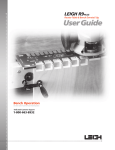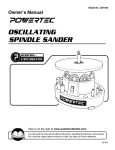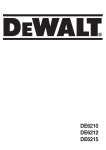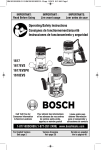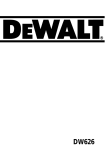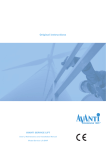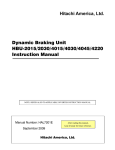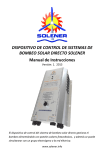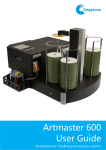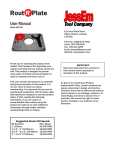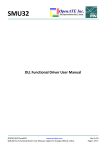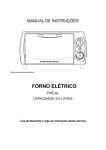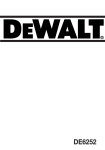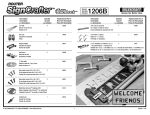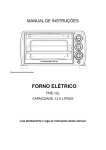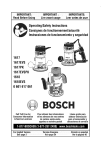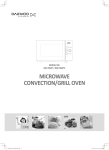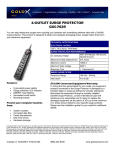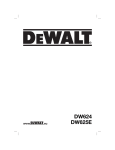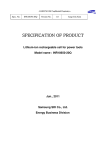Download User Guide - Leigh Jigs
Transcript
LEIGH R9PLUS Router Table & Bench Dovetail Jig User Guide Router Table Operation See other side of book for Bench Operation Dedicated Customer Support 1-800-663-8932 2 ROUTER TABLE OPERATION R9PLUS Dovetail Jig User Guide Introduction Your New Leigh R9 PLUS Dovetail Jig for Dovetails and Box Joints Note: There are two user guides in this book. This user guide is for Router Table Operation. Flip the book over for Bench Operation. The R9 PLUS Dovetail Jig was designed to overcome the restrictions of fixed width jigs. Because of its unique “step over” feature, it is possible to rout Through Dovetails and Box Joints on boards of ANY width! The R9 PLUS can be used as a template jig with a hand-held router or as a router table template. In either mode, you will be able to rout multiple sizes of perfectly fitting through dovetails and box joints. Important! Inches and Millimeters Text and illustrations in this English language user guide indicate dimensions in both inches and millimeters, with “inches” first, followed by “millimeters” in square brackets, i.e. 1⁄ 2"x 2"[12x50mm]. Do not be concerned that the inch/millimeter equivalents are not mathematically “correct.” Just use the dimensions that apply to your guides and bits. U.S. Patent No. 8,534,329 Customer Support If you have any questions that are not answered in this user guide, please call Leigh Customer Support: 1-800-663-8932 in North America or email [email protected]. For support contacts in your country of purchase see the Customer Support section of the Appendix. Reminder: If at first you don’t succeed, read the instructions! What’s in the Box: PART NO. QUANTITY PART DESCRIPTION 2000 1 2090 1 BAG 1 2030 2 2040 1 2080 1 BAG 2 2010 3 BAG 3 2050 2 2055 2 2060 2 2065 2 2070 11 2075 1 BAG 4 e10 1 80-8 1 160 1 172-8 1 730V 1 BAG 5 2020 2 9505 2 R9PLUS Template User Guide Latches Glide for Router Table Sidestop 2000 Pin Plates Beam Assembly Screws, ¼"-20 x 2¾" Beam Assembly Wing Nuts, ¼"-20 Latch Screws, Phillips 10-24 x ¾" Latch Nuts, Nyloc Wood Screws, Phillips Flat Head, No.8 x 1¼" Sidestop Screw, Phillips Round Head, No.8 x 1¼" e10 eBush (Guide Bushing) Dovetail Bit, ½"-8º Straight Bit, ½" Two Flute Collet Reducer, ½" to 8mm Pin Wrench Clamp Locators F-Clamps 2090 ROUTER TABLE OPERATION R9PLUS Dovetail Jig User Guide Introduction Contents 3 Dedicated Customer Support 1-800-663-8932 Chapter 1 Making the Beam5 Chapter 2 Glossary of Symbols11 Chapter 3 Using your Jig Safely13 Chapter 4 Basic Jig Functions15 Chapter 5 The Leigh eBush17 Chapter 6 Through Dovetail Joint Procedures Concept of Operation 21 Board Width Selection22 Through Dovetail Joints 23 Half-Pitch Through Dovetail Joints 25 Wide Boards 26 Chapter 7 Box Joint Procedures Concept of Operation 29 Board Width Selection30 3/8" Box Joints31 3/16" Box Joints33 3/4" Box Joints 34 Wide Boards 36 Appendix Customer Support37 R9plus Beam Drawing38 BAG 1 You will need: BAG 4 e10 2030 x 2 80-8 160 2040 172-8 2080 • A wooden beam 11⁄ 2" x 31⁄ 2" x 30". See jig assembly for optional beam sizes. • 5 ⁄ 8"[15mm] MDF for sacrificial backer boards and clamp face boards. See jig assembly for optional sizes. • A No.2 Phillips screwdriver 730V BAG 2 2010 x 3 • An electric drill, preferably bench or pedestal, but hand-held will work • 3⁄ 32" drill bit for pilot holes. Note: use 1/8" or 9/64" for hardwood. BAG 5 2050 x 2 • 3⁄ 4"[19mm] Forstner or similar bit for the clamp holes 2055 x 2 • 5⁄16" drill bit for the back up board holes, 2060 x 2 • A countersink bit 2020 x2 BAG 3 2065 x 2 2070 x 11 2075 9505 x2 • A router with adaptor for the e10 guide bushing 4 ROUTER TABLE OPERATION R9PLUS Dovetail Jig User Guide Introduction R9PLUS Bit Selection This chart shows all bits that can be used on the R9 PLUS. R 9 PLUS B I T S E L E C T I O N F C C A D E A Bit Diameter Leigh Bits A D E B B B* C Max. Shank Cutting Diameter Depth D Shank Length E Overall Length F Angle 3/8" 1/4" to 1/2" 8mm 1 3/4" 2 1/4" 8º 140-8 170 170C e7 & e10 172-8 7/16" 3/8" to 5/8" 8mm 1 3/4" 2 3/8" 8º 140-8 170 170C e7 & e10 172-8 3/8" 1/4" to 1/2" 8mm 1 3/4" 2 1/4" 8º 160 180 180C e10 172-8 7/16" 3/8" to 5/8" 8mm 1 3/4" 2 3/8" 8º 160 180 180C e10 172-8 1/2" 1/2" to 13/16" 8mm 1 3/4" 2 9/16" 8º 160 180 180C e10 172-8 5/16" up to 1" 8mm 1 3/4" 2 3/4" – – e7 172-8 5/16" 7/8" 8mm [5/16"] 1 3/4" 3" – – e7 172-8 5/16" up to 1" 8mm [5/16"] 1 3/4" 2 3/4" – – e7 172-8 1/2" up to 1 1/4" 1/2" 1 3/4" 3" – – e10 1/2" 1 1/4" 1/2" 1 3/4" 3 1/2" – 1/2" up to 1 1/4" 1/2" 1 3/4" 3 1/2" – 5/8" 1/4" Use with Use with Use with e-Bush Straight Collet Bit No. Reducer Half-Pitch Through Dovetails 70-8 75-8 Carbide Tipped Carbide Tipped Full Pitch Through Dovetails 70-8 75-8 80-8* 140-8 Carbide Tipped Carbide Tipped Carbide Tipped Carbide Tipped 170* High Speed Steel 170C* Solid Carbide 160* Carbide Tipped 180* 180C* – e10 High Speed Steel Solid Carbide – e10 1/2" collet required 1/2" collet required 1/2" collet required Box Joints 3/16" 166* 173* 173C* – – e10 5/8" 1/4" 1 3/4" 2 1/2" – – e10 1/4" collet 1/4" collet required Solid Carbide 1" 3/8" 1 3/4" 3" – – e10 172-375 High Speed Steel For 3/8" & 3/4" Joints 1" 3/8" 1 3/4" 3" – – e10 172-375 Solid Carbide For 3/8" & 3/4" Joints * Bits 80-8 and 160 included with the R9 Plus. * Spiral upcut bits rout cleaner and faster, leaving a smoother finish. R9PLUS Accessory Kit This kit offers great savings over individual prices. 2 7/8" required 3/16" 166C* 1 3/4" High Speed Steel 172-8 1/2" to 8mm collet reducer 1 1/4" long. For 8mm shank bits. 172-375 1/2" to 3/8" collet reducer 1 1/4" long. For 3/8" shank bits. Item ACR9 Includes: R9PLUS Pin Plates 3/8" dovetail bit (for through dovetails) 70-8 75-8 7/16" dovetail bit (for through dovetails) 140-8 5/16" straight bit (for half-pitch through dovetails) e7 eBush (for 70-8, 75-8 for half-pitch through dovetails) 166 3/16" spiral upcut bit (for box joints) 173 3/8" spiral upcut bit (for box joints) 172-3751/2" to 3/8" collet reducer 2010PR Package of 2 5 R9PLUS ROUTER TABLE OPERATION CHAPTER 1 Making the Beam The heart of the R9 PLUS Dovetail Jig is the beam. A typical beam, shown below, is 30"[762mm] long. A 30"[762mm] beam can accommodate board widths of up to 18"[457mm]. Beams can be made shorter (minimum 20"[508mm]) or longer, in 10"[254mm] increments. Because of the template’s unique “step over” ability, beams can be made longer to suit any width project. The beam is equally suited to router table or bench operation. The following instructions will guide you through the beam making process. Care in building the beam will ensure great joinery every time with the R9 PLUS. In addition to these instructions, a two page drawing, complete with all dimension information, is provided at the end of the user guide. Important: Please use this chapter’s step-by-step instructions in conjunction with the technical drawing on pages 38-39 of the Appendix. 6 Chapter 1 ROUTER TABLE OPERATION R9PLUS Dovetail Jig User Guide Making The Beam Important: Please use these step-by-step instructions in conjunction with the technical drawing on pages 38-39 of the Appendix. A B C 1-1 The beam assembly consists of the main beam A , the 1-2 Start with a straight, flat and square 30"[762mm] length sacrificial backer board B and the clamping surface C . We recommend making the clamping surface and sacrificial board from MDF, 1/2" to 3/4"[12,7 to 19mm] thick. Hardwood or softwood may also be used. of wood, 11⁄ 2" x 31⁄ 2" x 30"[38mm x 89mm x 762mm]. Note: A 30" section of common 2 × 4 can be used if it is straight, flat and square. B C B A A 1-3 Cut a piece of MDF 30" long and 21⁄ 8" wide [762mm 1-4 Lay out the mounting screw holes A and clamp holes B as x 54mm]. This will be your clamping surface A . Then cut your sacrificial boards 11⁄ 2" x 30"[38mm x 762mm]. You may want to cut a number of extra sacrificial boards now to use as replacements B. per the drawing on pages 38-39. Drill and countersink the screw holes on the clamping surface. Drill the 5⁄16"[8mm] holes C in the sacrificial board. This piece can be reversed and flipped four times to use up all four surfaces. C E D A B C B A 1-5 This procedure is critical to the accuracy of the jig. 1-6 Clamp a pin plate with its wide straight side flush to the flat Before attaching the MDF boards to the beam, use each pin plate as a drill guide. First, mark a line 41⁄ 2"[114mm] in from the left end of the top of the beam and square it across A. Next, stack the clamping surface B, sacrificial board C and beam D near the edge of the workbench and clamp in place E. bench surface A and its side edge on the line B. Using the 2 small holes C in the pin plate as a drill guide, drill two 3⁄ 32"[2,5mm] pilot holes 1"[25,4mm] deep. These holes will correctly position the pin plate on the beam. Note: If you are using hardwood, redrill these holes with a larger bit, 1/8" or 9/64", to avoid breaking screws. ROUTER TABLE OPERATION R9PLUS Dovetail Jig User Guide Making The Beam Chapter 1 7 7" A A B 1-7 Use two No.8 x 11⁄ 4" [38mm] wood screws (included) to 1-8 Square a second line across the beam board exactly 7" attach the first pin plate with its left edge flush to the line on the top of the beamA. Note: The pin plate is moved up from the drilling position (see 1-6) to align the screw slots in the pin plate with the pre drilled holes [178mm] from the right edge of the first pin plate A. Clamp the second pin plate B flat on the workbench and against the line. Repeat the drilling and attaching procedure as before. lightly Repeat this procedure for each successive pin plate. A C A B B 1-9 Assemble the Latches There are three parts to each 1-10 Pin Plate “Pin” The template has positioning holes that latch assembly: the latch screw A, the nyloc nut B and the plastic latch C. Press the nyloc nut into the hexagon opening in the top of the plastic latch with the white nylon insert facing up. Next, screw in the latch screw from the bottom of the latch. Do not tighten the screw at this time. allow it to sit perfectly on top of the raised pin A of each pin plate. The pin plate sits flat on the beam B. Note: When the sacrifical board C is installed, the top of the pin plate will be level with the top of the sacrificial board. A A A A 1-11 Attach the latches to the keyhole slots and turn to engage 1-12 Mount the template on the left pair of pin plates using the the pin plates A . Adjust the latch screw tension so that the latches are stiff to turn onto the plates (seen from underside of the template). 7⁄ 16"[11mm] pin position A. 8 ROUTER TABLE OPERATION R9PLUS Dovetail Jig User Guide Chapter 1 1-13 Turn the assembly upside down. Take a piece of the predrilled sacrificial board and lay it flush on the template. Making The Beam 1-14 Using the two 5⁄ 16"[8mm] holes as drill guides, drill two 5⁄16"[8mm] holes through the beam. Attach the sacrificial board at the left end with a ¼-20 machine screw and wing nut. Then move the template to its second position and install the second screw. B A A C B D 1-15 Place the clamping surface A against the beam B, flush against the sacrificial board. Be sure the clamp hole layout marks C are next to the sacrificial board D. Screw the clamping surface to the beam through the countersunk holes. If screwing into a hardwood beam, first drill pilot holes in the beam. " 4 1/2 ] 1-16 Clamp Holes Drill all 3⁄ 4"[19mm] clamp holes A square to the beam, through the clamping surface and beam. Next, drill two holes (as per beam drawing), 5⁄16"[8mm] diameter and 9⁄ 16"[14mm] deep, for the table glide B (used for router table operation only). m] "[8m 5/16 mm [114 m] "[47m 1 7/8 .x B p dee 1/4" ] A "di[8amm x 6.35m /16 A 5 m REV 040314 1-17 Sidestop Positioning Create layout lines as indicated 1-18 Using a Brad Point or Forstner bit, counter bore a above for the sidestop A. Note: Be precise. Sidestop positioning is very important. 5⁄ 16"[8mm] hole A , 1⁄ 4"[6,35mm] deep for the sidestop hub. Then, using a 3⁄ 32"[2,5mm] bit, drill a pilot hole for the sidestop mounting screw. Attach the sidestop to the beam with the provided No.8 x 11⁄ 4"[30mm] round head screw B. ROUTER TABLE OPERATION R9PLUS Dovetail Jig User Guide Making The Beam Chapter 1 9 B 90 90ºº A A C A A 1-19 The template will now be used to precisely position the pin plates. Slightly loosen all pin plate screws A just enough so that the pin plates can move side to side. Position the template on the pin plates in the 3⁄ 8"[9,5mm] position B. Set the sidestop to the TD Max position C. 1-20 Clamp a square board against the sidestop and flush under the template. Insert the shank of the No.80-8 bit into the 5⁄16"[8mm] hole in the template. Move the template and pin plates laterally until the shank of the bit just touches the edge of the board. Now tighten the first pin plate. A 1-21 Gradually tighten the second pin plate screws A making sure the template is not binding on the pins. Move the template to the second position and repeat the procedure with the third pin plate. 1-22 Optional Hold-down for Bench Use Notch out the ends of the beam in order to clamp beam assembly to a bench and use in hand-held router mode. ■ Important: The beam may expand or contract with humidity changes. Use the 3⁄ 8"[9,5mm] holes to adjust the pin plates as required. 10 Chapter 1 ROUTER TABLE OPERATION R9PLUS Dovetail Jig User Guide Making The Beam 11 R9PLUS ROUTER TABLE OPERATION CHAPTER 2 Glossary of Symbols Which Way Around Should the Board Go? The following symbols/icons are used throughout this user guide. They indicate which side of a board faces out (toward you, the operator, when clamped in jig), which faces are in or out when assembled, and which edge goes against the sidestop. Dashed line icons indicate the other side of the board. “Outside” of board “Inside” of board “Either side“ of board “Outside” of board (on other side of board) “Inside” of board (on other side of board) “Either side“ of board (on other side of board) “This edge” against side stop “This edge” against side stop “This edge” against side stop (on other side of board) 2-1 Icons such as the one above indicate which side of the board “This edge” against side stop (on other side of board) faces out (toward you, the operator) when clamped in jig, and which faces are in or out when assembled. 2-2 Box joint boards are clamped against the beam both “face 2-3 Note: Because through dovetail pin and tail boards face in” and “face out” for alternate end cuts. With box joints, the same side edge always goes against the sidestop. only one way, both side edges are (alternately) used against the sidestop. ■ 12 Chapter 2 ROUTER TABLE OPERATION R9PLUS Dovetail Jig User Guide Glossary of Symbols 13 R9PLUS ROUTER TABLE OPERATION CHAPTER 3 Using Your Jig Safely Safety is not optional. Read and follow the recommendations in this chapter. 3-1 Read the owner’s manual that came with your router. It 3-2 Always wear: is essential to understand the router manufacturer’s instructions completely. 3-3 Never drink alcohol or take medications that can cause drowsiness while operating a router. • approved safety glasses; • a face mask to protect yourself from harmful dust; • hearing protection. 3-4 Always disconnect the power source from the router when fitting bits or guide bushings, or making adjustments. Before connecting the router to the power source, make sure the bit and collet revolve freely in all the areas you plan to rout, not touching the guidebush or jig. 14 Chapter 3 ROUTER TABLE OPERATION R9PLUS Dovetail Jig User Guide 3-5 Do not tilt the beam. Keep the beam flat on the router table. Using Your Jig Safely 3-6 Chips and sawdust are thrown out at high speed. Always stand and use the beam from the opposite side of the chip and sawdust ejection. ■ 15 R9PLUS ROUTER TABLE OPERATION CHAPTER 4 Basic Jig Functions Router Table Surface Template Orientation Pin Plate Positioning Routing Position Sidestop Clamping Procedure Note: The images in this user guide show the “action” side of the jig, however the operator stands behind the router table, away from the chips and sawdust thrown off by the router bit. B C A A B A Router Table Surface Template Orientation 4-1 When using the R9 PLUS on a router table, be sure there are 4-2 The engraved side of the template always faces up. Template no height differences between the table and any lift mechanism A, guide bushing B or bushing adaptor C. The template must slide smoothly over the table top. positioning holes A are for through dovetail pins. Template positioning holes B are for through dovetail tails and box joints. A B A B Pin Plate Positioning Routing Position 4-3 The beam is positioned on the template using the pin plate 4-4 Always begin routing from the left end of the jig when positioning holes A and B. Most illustrations will have an inset showing the correct template pin position for the procedure. viewed from the operator’s position. 16 Chapter 4 ROUTER TABLE OPERATION R9PLUS Dovetail Jig User Guide Basic Jig Functions A Sidestop Clamping Procedure 4-5 The sidestop is set on one of the five positions, depending 4-6 Each of the F-Clamps included with the R9 PLUS is fitted on the part or type of joint being routed. The sidestop pictured above is in the TD (Through Dovetails) mode. with a clamp locator A. The clamp locators are pressed onto the clamp arm and should not be removed. A 4-7 Squeeze the tips of the clamp locator A and insert through a clamp hole in the beam. Clamp locators hold the clamp arm firmly in place while the clamp’s screw arm is attached from the opposite side of the beam. 4-8 All boards are clamped against the sidestop and flat on the template. ■ 17 R9PLUS ROUTER TABLE OPERATION CHAPTER 5 The Leigh eBush Note: Normal tolerances with bits, guide bushings and router runout will generally produce poor fitting joints. Leigh elliptical guide bushings (e7 and e10) solve this problem. Patents for all Leigh elliptical guide bushings: U.S. 8,256,475 UK GB2443974 Joint Fit Adjustment A B A B 5-1 The Leigh eBush barrel is elliptical A , unlike plain 5-2 With the eBush turned to “10” A in the base the active circular template guidebushes B. When rotated, the effective diameter of the barrel changes, allowing fit adjustments as small as .001"[0.025mm]. The e10 eBush is included with the R9 PLUS. “diameter” is increased, allowing less side-to-side movement, resulting in smaller sockets and larger pins. Turning the eBush to “0” B allows more side-to-side router/bit movement and more wood removal, producing larger sockets and smaller pins, and thus a looser fit. A 5-3 Make a small scratch line or permanent ink mark on the 5-4 Adjust the eBush with the pin wrench. Markings on the router table insert at the 12 o’clock and 6 o’clock position. This will help you steer the template along and between the guide surfaces. All settings for the eBush will be aligned to the scratch or ink marks. The eBush will always be set on 5 as a starting point for dovetails and box joints. eBush indicate which way to turn it for a looser or tighter fit. 18 Chapter 5 ROUTER TABLE OPERATION R9PLUS Dovetail Jig User Guide The Leigh eBush 35 35 5-5 One division of the eBush changes the joint glue line by 0.002" [0.050mm]. A perfect fit will be established with one or two test cuts. 5-6 Record the eBush setting here for a quick setup the next time you use this bit/guide bushing combination. ■ eBushes and Adaptors eBushes eBushesand andAdaptors Adaptors The Leigh eBush guide bushing fits directly to most popular router models such as Porter Cable, Black & Decker and The Leigh eBush guide bushing fits directly to most popular router models such as Porter Cable, Black & Decker and Dewalt. Many The Leigh eBush guide bushing fits directly most popular router Black & Decker and Dewalt. Many other makes, e.g., Bosch, Fein, to Festool, Milwaukee, etc.models either such offerasorPorter come Cable, complete with base adaptors Dewalt. Many other makes, e.g., Bosch, Fein, Festool, Milwaukee, etc. either offerwith or come complete with base the adaptors other makes, e.g., Bosch, Fein, Festool, Milwaukee, etc. either offer or come complete base adaptors that accept eBush. In that accept the e-Bush. In addition Leigh offers the nine adaptors below to allow the use of over one hundred other that accept the e-Bush. In addition Leigh offers the nine adaptors below to allow the use of over one hundred other addition Leigh offers the nine adaptors below to allow the use of over one hundred other router models, new and old. For the complete router models, new and old. For the complete list of routers, see the e-Buh Adaptor Selection Chart on the next page. models, and old. For the complete liston ofthe routers, see the e-Buh Adaptor Selection Chart on the next page. listrouter of routers, see new the eBush Adaptor Selection chart next page. eBush eBushAdaptors Adaptors e7 e7 e10 e10 Bosch Bosch RA1100 RA1100 eBushMounting Mounting Variations eBush Variations 721 721 Bosch Bosch RA1126 RA1126 704R 704R (requiredfor for (required BoschRA1100) RA1100) Bosch eBush with eBush with Adaptors && 702R Adaptors702 702 702R eBushes fit many eBushes fit many routers directly routers directly eBush with Adaptor eBush 703 with Adaptor 703 eBush with Adaptor 710 eBush with Adaptor 710 705R 705R 702 702 706R 706R 702R 702R 703 703 710 710 Nut for eBushes Nut for eBushes ROUTER TABLE OPERATION R9PLUS Dovetail Jig User Guide The Leigh e-Bush Chapter 5 eBush Adaptor Selection In order to fit your Leigh eBush to your router, you may need an adaptor. Find out in the chart below. See www.leighjigs.com for the complete list of routers. DIRECTIONS A. Locate name of router maker in Column 1. B. Locate router model in Column 2. If your router is not listed visit leighjigs.com for a complete, up-to-date list of routers. C. Locate adaptor required for your router in Column 3. •O rder Leigh adaptors (part no’s in red) in Column 3 from Leigh. •O rder Bosch adaptors RA1100 and RA1126 in Column 3 from Leigh or your Bosch dealer. •O rder all other adaptors in Column 3 from the router manufacturer’s dealer. ■M AFELL – Rework adaptor slightly. Router not listed? If your router is not listed in this chart, you may be able to fit a “universal baseplate” to your router. Please contact Leigh for assistance. 1 ROUTER MAKER BLACK & DECKER BOSCH CMT CRAFTSMAN (SEARS) DEWALT Adaptor Mounting Screws Screws are included with router. Adaptors for Router Tables Leigh guide bushings and eBushes are based on the industry standard 1-3/8" 2-piece design. Most router tables have adaptors that accept these standard guide bushings. If your router table does not have a suitable adaptor, please check with the router table manufacturer. Guide Bushings All 8mm shank through dovetail bits listed in this chart work with either the e7 bushing (7⁄16" OD) supplied with your Leigh jig, or with any 7⁄16" OD guidebush. The optional Leigh e10 bushing or standard 5⁄8" OD guidebush is used with 1⁄2" shank bits. No other guidebush sizes can be used for through dovetails. ELU FEIN FESTOOL FREUD HITACHI MAFELL MAKITA MASTERCRAFT METABO MILWAUKEE 2 ROUTER MODEL 3 ROUTER ADAPTOR All Professional, HD1250, RP400K,7614 Not Required 6200 720673-00 SR100, 7AEE, KW780 series, KW 800, KW850 710 1600, 90085, 90088, 90098, 90140, 90150, 90300, 90303, 90305, 91264 Aftermarket base plate required 1601, 1602, 1603, 1604, 1606, B1350 RA1110 North American ROUTERS PRODUCED AFTER mid-2010: 1613EVS, 1613AEVS, 1617, 1617EVS, 1618, 1618EVS, 1619EVS, MR23EVS, MRC23EVS, MRF23EVS, MRP23EVS RA1126 quick change adaptor and RA1100 bushing adaptor required North American ROUTERS PRODUCED BEFORE mid-2010 and others available worldwide that include the RA1126 adaptor: 1613, 1613EVS, 1613AEVS, 1614, 1614EVS, 1617EVS, 1618EVS, 1619EVS, B1450, GOF900, GOF900CE, GOF900ACE, GOF1200, GOF1300CE, GOF1300ACE, GOF1600CE, GOF2000CE, GMF1400, GMF1600CE, POF800ACE, POF1100AE, POF1200AE, POF1400ACE RA1100 1611, 1611EVS, 1615, 1615EVS, B1550, GOF1600, GOF1700ACE 702 1E 702R All non-plunge models Aftermarket base plate required 135275070 Plunge See Skil 1823 or 1835 Other plunge models 702 MD11 Plunge & Fixed Base. MD9.5 Fixed Base Not Required DW610, DW616, DW618 Not Required DW613, DW615(UK) 710 DW614, DW615, DW621, DW624, DW625, DW626 N. America Only, Supplied w/router DW621K & DW626 outside N. America 706R DW625 Type 1,2,3,5 outside N. America 702 DW624 & DW625 Type 4 outside N.America, DW625EK 702R OF15, OF15E, OF97, OF97E 706R MOF68, MOF69, MOF96, MOF96E 710 MOF131, MOF177 Type 1,2, & 3 702 MOF177 Type 4, MOF177EK 702R 2720, 2721, 3328 Not Required 3303, 3304 EO9600 or 761 270-00 3337, 3338, 3339 702 RT1800 Supplied w/router OF1E , OF2E, OF650, OF900E ,OF1000, OF1010E 704R OF2000, OF2000E 705R OF1400 and OF2200 North America Only Supplied w/router OF1400 Outside North America 493566 OF2200 Outside North America 494627 O-Ring may be required to keep bushing centered FT700(2), FT2000, FT2200, FT3000 721 TR8, TR12, FM8, M8, M12 Series 325211 OR 703 M12VC, KM12SC, KM12VC Not Required M12SA2, M12V2 325224 LO65E 702 n RP1801, RP2301, 3612C Europe Qk Fit Base 721 3600, 3606, 3608, 3612, 3612B, 3612BR, 3612C N. America, 3620, 3621, RP900K 703 3601B 321 493-1 RP0910, RP1110C 706R RF1100, RF1101, RD1100, RD1101, RP1101 Not Required Please contact Leigh for assistance OF1612, OFE1812 (for all others, please contact Leigh for assistance) 704R 5615, 5616, 5619 49-54-1040 5625 49-54-1026 5670 Not Required PERLES OF808 Series, OFE6990 710 PORTER CABLE (ROCKWELL) All Not Required or Supplied w/router RIDGID R2930 (for all others, please contact Leigh for assistance) 704R R30, R50, R150, R151, RE155, R500, R501, R502 703 RYOBI R600, R601, RE600, RE601 702 R160, R161, R162, R163K, R165, R170, R175, RE175, R180, R180PL, R181, R185, ERT1150 706R 1823 or 1835 91803 SKIL SK1810, 1815, 1820, 1825 RAS140 All others Aftermarket base plate required TREND T3, T4, T5, T9, T10, T11 – UniBase required 710 TRC001 TGA006 or 704R JOF001, MOF001, TRA001 Accessory Kit (includes adaptor) TGA001 or TGA150 OF850 Series 710 TRITON WEGOMA 19 20 Chapter 5 ROUTER TABLE OPERATION R9PLUS Dovetail Jig User Guide The Leigh e-Bush




















